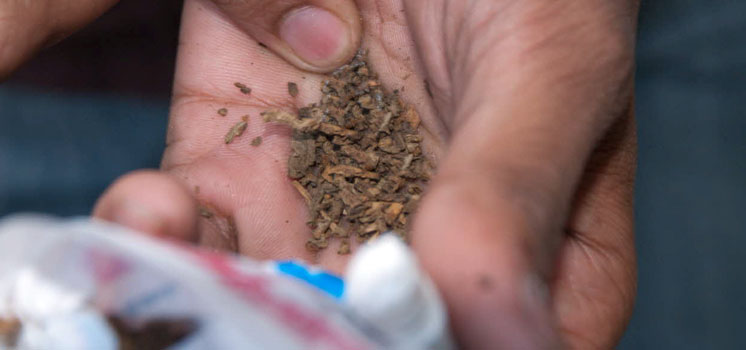Smokeless tobacco
In many parts of the world, including in the WHO Eastern Mediterranean Region, people use smokeless tobacco. The tobacco is usually chopped up and moistened, and is used by chewing it or holding it in the mouth between the gum and the cheek.
Chewing tobacco is sometimes mixed with other substances including herbs, spices, areca nut, betel leaf and slaked lime. Different forms include paan, naswar, chalia/supari and gutkha. Gutkha is a commercially-manufactured smokeless chewing tobacco that is a sweetened and flavoured dry mixture which is increasingly popular among young people and women in some countries.
Health risks of smokeless tobacco use
Smokeless tobacco use is highly addictive and damaging to health. The nicotine in smokeless tobacco is more easily absorbed than by smoking cigarettes enhancing its addictiveness. Smokeless tobacco contains many cancer-causing toxins and its use increases the risk of cancers of the head, neck, throat, oesophagus and oral cavity (including cancer of the mouth, tongue, lip and gums) as well as various dental diseases.
In Pakistan, where rates of smokeless tobacco use are high (and higher than cigarette use), oral cancer rates are among the highest in the world, and are significantly higher than other countries of the Region. Oral cancer is the second leading cancer there after breast cancer. Smokeless tobacco users have much higher rates of oral cancer than non-users.
Gutkha has been strongly implicated in an increase in oral submucous fibrosis, a very malignant and debilitating condition with no cure. This rise is being seen especially among young people, even after a short period of use.
Increasing use of smokeless tobacco
Smokeless tobacco use in the Region is increasing rapidly, especially among young people and women. The Region has some of the highest rates in the world with overall rates of use of tobacco products other than cigarettes (including smokeless tobacco) of 14% among boys age 13–15 (compared to 7% cigarette use) and 9% among girls age 13–15 (compared to 2% cigarette use). Rates are even higher in some countries of the Region. In many countries, more women and young people use other tobacco products than smoke cigarettes.
Underlying this increase is the misperception that use of tobacco products such as smokeless tobacco is less harmful to health than smoking cigarettes. Smokeless tobacco is not a safe alternative to cigarettes. However, the health dangers of smokeless tobacco use are little understood by users.
Marketing smokeless tobacco
Smokeless tobacco is being increasingly marketed by the tobacco industry. This includes marketing to cigarette smokers as an alternative in situations in which smoking is not allowed. It is also marketed to young people to promote initiation of tobacco use. Smokeless tobacco is often easier for young people to obtain than cigarettes and is easier to use without drawing attention.
Smokeless tobacco has not had the same amount of regulation as cigarettes. In most countries, the smokeless tobacco sold does not carry health warnings on its packaging. This reinforces the perception that smokeless tobacco use is relatively safe compared to cigarettes.
Best practices and the way forward
Smokeless tobacco use should be subject to the same regulation as cigarettes and other tobacco products. This includes application of Article 9 of the WHO Framework Convention on Tobacco Control on the regulation of the contents and emissions of tobacco products, Article 10 on the regulation of tobacco product disclosures and Article 11 on packaging and labelling of tobacco products.
Smokeless tobacco use should be included in tobacco control efforts. This includes:
prohibition of misleading labelling and claims of reduced harm and safety
having health warnings on smokeless tobacco packaging
education of the public and health professionals about the health risks of smokeless tobacco use
cessation interventions for smokeless tobacco users.









